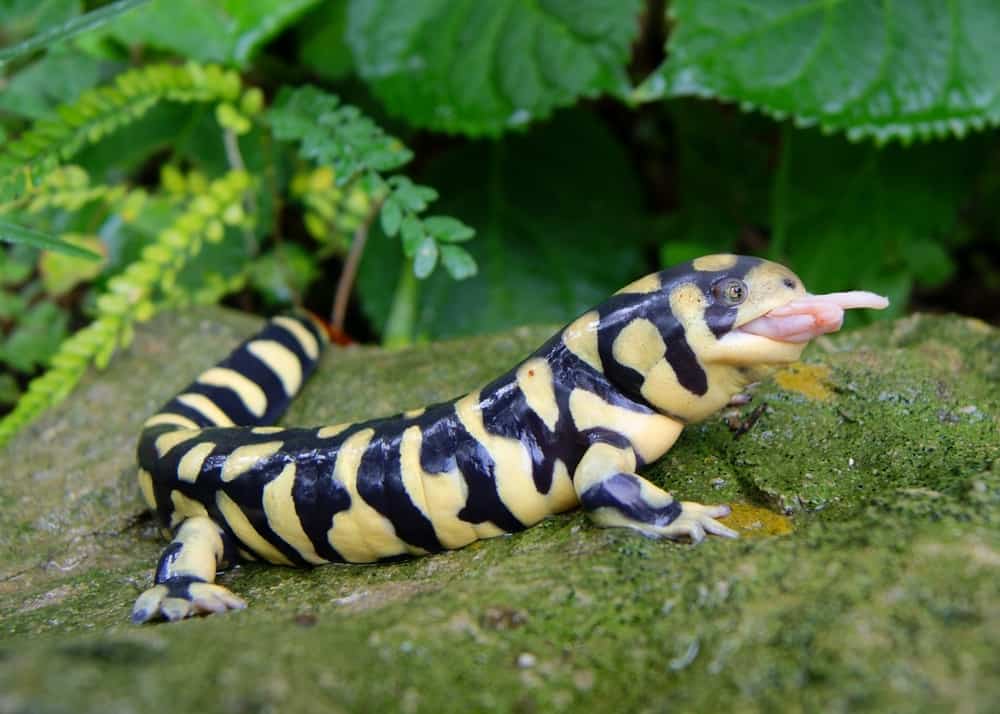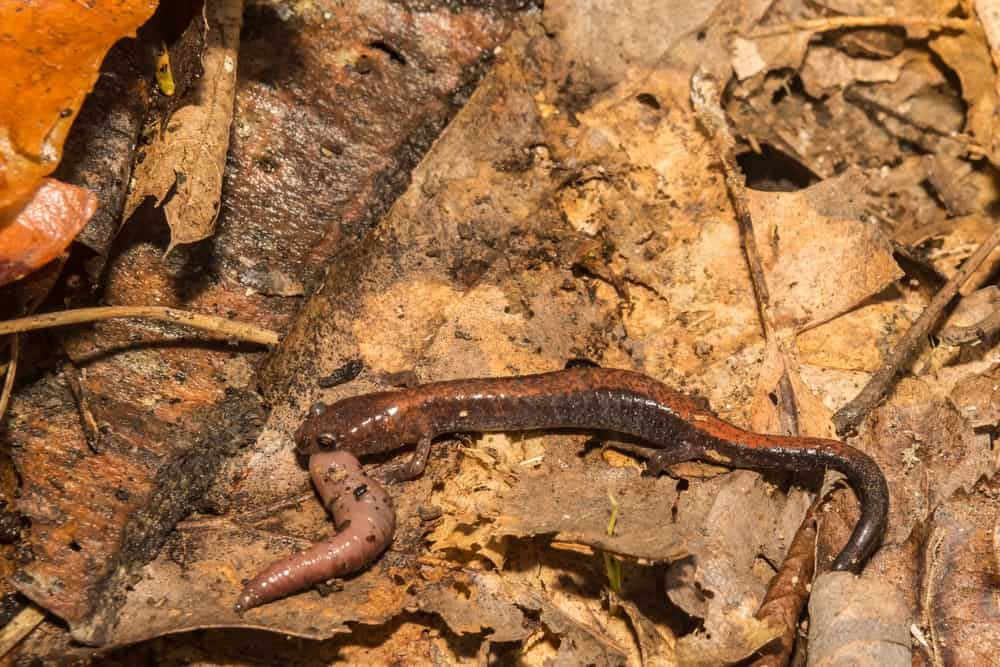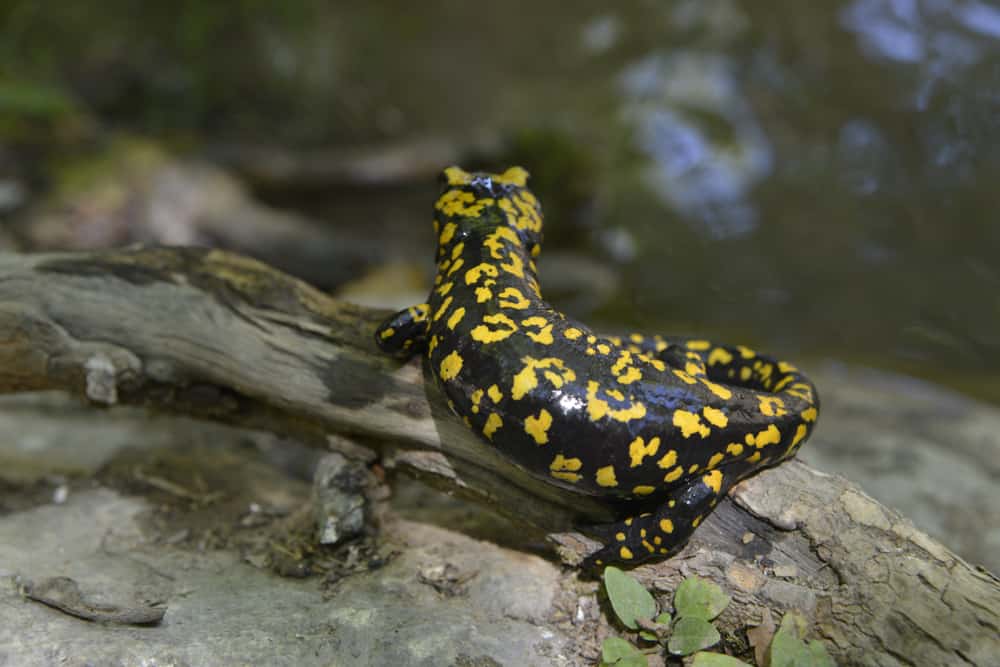The species and habitat of salamanders are essential in determining their diet. While terrestrial species solely feed on prey found on dry land, aquatic salamanders eat both marine and land-based prey. This rule applies to salamanders kept as pets too; for the best nutrition, owners must provide food that’s suitable for their specific species.
Salamander Habits and Biology
Salamanders are amphibians often characterized by their lizard and froglike appearance. They have long, slim bodies, long tails, and smooth, moist skin.
There are many types of salamanders. Some have four legs and others have two, some use gills to breathe, others use lungs and others have neither gills nor lungs – they breathe through the skin.
Salamanders vary in size too. However, the majority are usually around 6 inches long. The largest species is the Japanese Giant Salamander that grows up to 5 feet in length and 55 pounds in weight. The smallest salamanders are pygmy species that grow only 0.6 inches long.
Like most amphibians, salamanders are nocturnal creatures and will mostly come out to eat at night. During the day when the weather gets hot, they will rest under rocks, inside logs, or in trees to keep cool.
Their brightly colored skin helps keep predators away. Many also have glands around their tails and necks that secrete a poisonous liquid that kills their predators. Some species can even squeeze the sharp tips of their ribs through the skin to poke into their enemy.
While salamanders can be found all over the world, their habitat will depend on the species. Newts, for instance, spend the best part of their life on dry land and their skin is rough and dry.
Sirens, on the other hand, spend most of their lives in moist areas. These days, humans are keeping salamanders as pets too. No matter where a salamander resides, it must keep its body moist.
Fun Fact: Salamanders can lay more than 400 eggs at once. Many are good moms and will stay with their eggs to protect them. Some will even cover each egg with a leaf for extra protection.
This video has everything you need to know about salamanders’ biology, habitat, and behavior:
What Do Salamanders Eat in Their Natural Habitat?
As stated, what a salamander eats will be greatly influenced by its species and where it lives. Species that live on dry land have sticky muscular tongues that they use to catch their prey.
Aquatic species, on the other hand, lack sticky tongues. They catch their meal by opening their wide mouths and ambushing or outswimming the prey. Also, unlike their land-based cousins, the majority of marine salamanders are omnivores, meaning, they can feed on both meat and leafy food items.
However, no matter the species, all salamanders are nocturnal and will catch and eat their prey during the night.
Here is a video of a marine tiger salamander scouting for food and catching its prey:
What Do Salamanders Like to Eat?
Terrestrial salamanders will mostly feed on the following:
Aquatic species will typically eat the following:
- Crickets
- Shrimps
- Snails
- Minnows
- Algae and other aquatic plants
Larger marine salamanders may also feast on mice and frogs, and sometimes, they have been found to be cannibalistic.
Benefits of Salamanders’ Diet to the Ecosystem
- Salamanders are essential in balancing the population of insects and arthropods such as ticks and mosquitoes that can be a nuisance to humans. Both ticks and mosquitoes transmit a variety of diseases through their bites. By feeding on these bugs, salamanders significantly minimize bites and the spread of illnesses.
- By preying on beetles, snails, ants, earthworms, and other invertebrates, salamanders also help reduce the effects of global warming. Without salamanders, these organisms will feed on fallen plant leaves and forest debris and release carbon into the atmosphere.
- Salamanders help minimize house fires too by consuming rodents that chew on electricity cables within walls and attics.
- With salamanders, crop damage is also diminished. Many insects they feed on have been linked to crop destruction that affects farms and food supplies. Reducing the population of insects not only helps in controlling pest infestations but also guarantees higher yields.
What Do Salamanders Eat as Pets?
Like untamed salamanders, what to feed pet salamanders will depend on the habitat they were obtained from.
- Feed terrestrial species bugs and worms: These can include crickets, mealworms, earthworms, buffalo worms, maggots, and mosquito larvae. This type of food offers plenty of nutrients that are beneficial to your salamander. It can be found at any pet store.
- Feed marine species aquatic organisms: While you may feed your salamander regular bugs like flies, earthworms, and blackworms once in a while, water-dwelling salamanders will tend to enjoy marine organisms more. Get them things like shrimp, minnows, crayfish, or nightcrawlers. Any pet store will have these but you can also check at the tackle shop.
- Water: While salamanders need to stay hydrated, they take water into their body the same way all amphibians do. This means that instead of drinking like other pets, salamanders will absorb water through the skin. So, make sure your salamander’s tank has pools of water at the bottom. Use chlorine-free tap water or bottled water.
10 Tips to Feed Salamanders
1. Give Your Salamander Appropriately-Sized Food
Young salamanders will typically not eat the same sized food as adults. If you have a few of these, you should give them smaller foods like fruit flies, small crickets, small grubs, and sliced worms. Their mouths are still not large enough to eat big bugs.
2. Do Not Feed Dead Prey
Salamanders prefer to hunt their own food rather than eating dead food. As such, make sure you are giving your pet live bugs and worms. The only species that have been found to enjoy dead food is the fire salamander. This one can even be fed from a tray.
3. Avoid Feeding Wild Caught Bugs
Catching bugs outside is not just too much work; it can also harm your salamander. The bugs may carry diseases or may have been exposed to dangerous chemicals. Always get your food from a pet store, tackle shop, or other dealers who supply live food.
4. Choose Food Available in Their Natural Habitat
Just because your cat eats human food doesn’t mean your salamander will do the same. Salamanders’ bodies are not built to digest human foods and even if they were, amphibians generally do not consider the meat and vegetables eaten by humans as food. They will only go for foods they know from their natural habitats like bugs and small invertebrates.
5. Feed Salamanders 2 to 3 Times a Week
Unless you have one of these giant salamanders, you really don’t need to give your salamander food every single day. Most adult salamanders will only require feeding 2 to 3 times a week. When in doubt, talk to a reptile veterinarian to know how often you should feed your specific species.
6. Offer Sufficient Food for One Sitting
Watch your salamander to see how much food they can eat in one sitting. After a couple feedings, you will be able to know how much you should feed them.
Most salamanders will spend about 10 to 15 minutes on food in one sitting. If they are leaving food, don’t feed too much next time. Similarly, if they start to get fat, feed them less.
7. Introduce Supplements
Supplements can help keep your pet looking healthy. You should sprinkle their food with a calcium supplement at all times and a multi-vitamin supplement at least once a week. You can buy supplements for your salamander online or at a pet store.
8. Offer Different Food Items
Like humans, salamanders don’t want to eat the same food every single time. In their natural habitat, they would have a variety of bugs to prey on. Recreate this experience for them by offering a varied diet.
9. Do Not Leave Uneaten Food for Later
Always remove uneaten food from the tank. Even if you leave it there, your salamander will not have a midnight snack. In fact, you will only be putting them in danger, as some of these bugs can bite or develop bacteria that can contaminate the water in the tank.
10. Feed Reluctant Salamanders By Hand
Some salamanders may refuse to eat when they are in a new habitat. If a salamander you just got won’t eat, consider feeding them yourself. Try picking up the live bug with a toothpick or dangling it near their mouth, and wait for them to eat it. If the problem persists, talk to a vet.
Summary
Salamanders will feed on anything that moves that can fit inside their mouths. Whether in their natural habitat or in captivity, they will consume most of the creatures that humans consider pests such as flies, ticks, worms, mosquitoes, slugs, rodents, and beetles, which helps keep these bothersome bugs under control.



Thank you so much for the help!!!